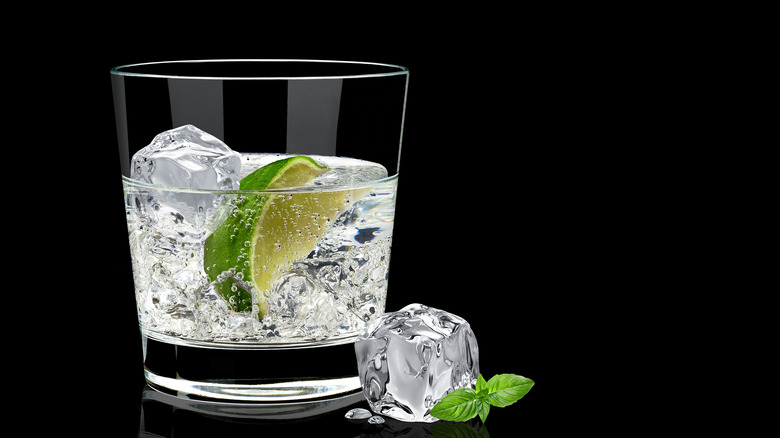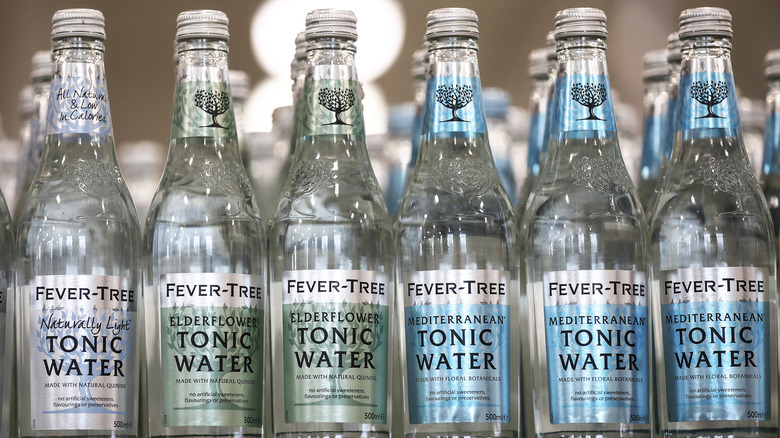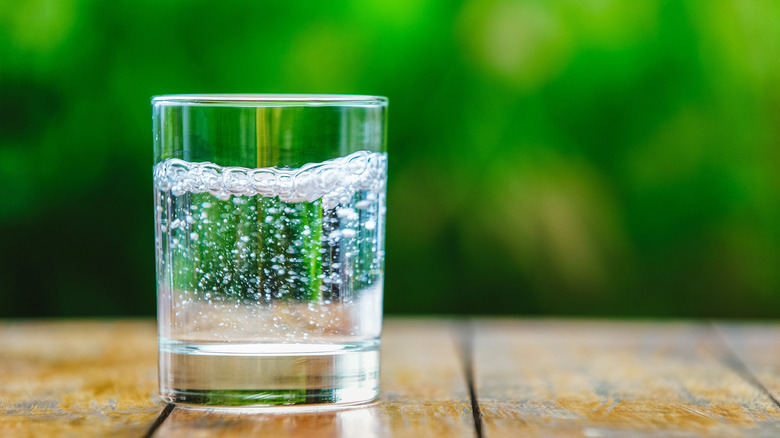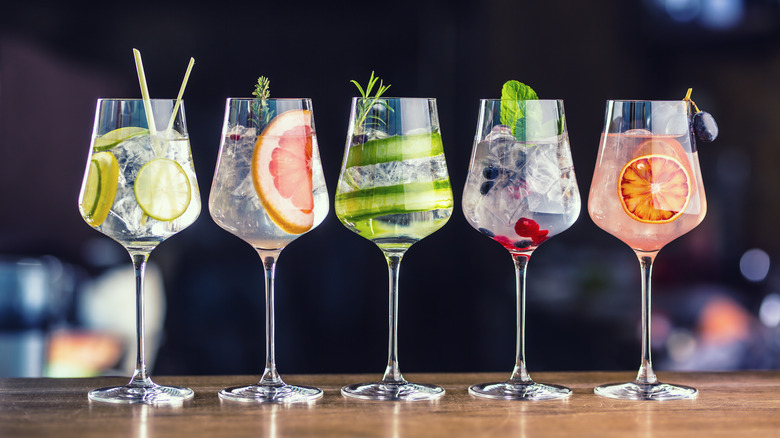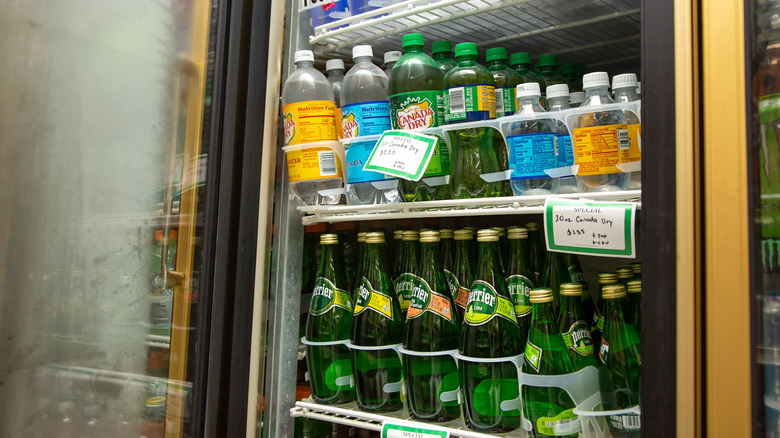What Is Tonic Water And Why Do You Drink It?
As far as iconic duos go, a gin and tonic is pretty high up on the list. The classic combination is available at almost every bar and restaurant that serves booze. What exactly makes up the classic cocktail? Even with a simple mix of just gin, tonic, and lime, the drink packs in a punch of flavor.
Tonic water stands out from other sparkling mixers with its bitter taste. But what's the story behind the beverage's bitterness? Tonic's history actually does not begin behind a bar, notes Mental Floss. Instead, the popular beverage's roots begin with a tree. Yes, an actual tree, the cinchona tree to be exact (via Mental Floss). The bark of the tree is responsible for the drink's tell-tale bitterness, thanks to one of the beverage's main ingredients — quinine. And at its inception, mixing it with a spirit and getting a buzz wasn't the main purpose of tonic. Instead, way back in the 1800s, it was originally used for medicinal purposes.
Tonic water's history
According to Mental Floss, it wasn't until 1767 that scientists figured out how to carbonate drinks. And as carbonated beverages were becoming more popular and accessible, Britain was sending people all across the globe, looking to colonize it, say Mental Floss. With the travel came malaria, which became a huge issue — killing many British citizens and remaining prevalent in newly colonized regions. Enter tonic water.
Tonic water got its name and beginning due to the malaria outbreak of that time. The idea, notes Mental Floss, originated with indigenous Peruvians who knew to use "cinchona tree bark to treat fevers." The bark was brought back to Europe and began its use as a malaria treatment. It was the bark's quinine, an ingredient still in tonic water today, that aided the illness, says Mental Floss. But the bark on its own was bitter and didn't go down easily. To tame the taste, it was infused into carbonated water and mixed with sweetener — and became a tonic. According to Mental Floss, 1858 was the first year that the beverage was commercially marketed. Mixology explains that it was Erasmus Bond of London who was awarded the first patent for tonic water.
Tonic's ingredients and what it tastes like
Essentially, classic tonic water is carbonated water mixed with quinine. Due to its quinine content, tonic water has a tell-tale bitterness. The Spruce Eats describes the drink's flavor profile with a presence of "citrus, herbal, and spice notes." Tonic water has added sugar, so the sweetness plus the drink's sparkling nature make its bitterness more palatable.
Even with its sugar content, tonic doesn't quite compare to a soda. The beverage is much drier and doesn't have the syrupy taste that sodas are known for — despite the fact that it is carbonated water mixed with syrup, just like soda. The Spruce Eats says that as far as ingredients go in tonic syrup, in addition to quinine (that could be natural or artificially made) and sweetener, it is not uncommon to find botanicals and additives like "citrus peels or oils ... allspice, cinnamon, elderflower, gentian, ginger, lavender, and lemongrass." All of which contribute to the beverage's flavor.
How to drink it
Drinking tonic water on its own is not unheard of, but it's much more popular to enjoy the beverage with booze. Gin, says Mental Floss, was becoming popular around the same time tonic went commercial, and the duo have been an iconic pair ever since.
While a gin and tonic with a lime is a classic cocktail, there are other spirits that go well with the simultaneously sweet and bitter nature of tonic water. Vodka is another popular pairing. Irish whiskey, rum, and tequila can also be served with the bubbly beverage. No matter what mix-in you choose, drinks with tonic water most often keep it simple and contain few ingredients, often just the spirit, tonic, lime, and ice. As a nonalcoholic tonic sipper, Eater notes that espresso tonic — made simply with shots of espresso, tonic water, and ice — has proved a popular mix in recent years.
Is quinine safe?
While the quinine content of tonic was originally intended to keep drinkers healthy, when consumed in large quantities, quinine can cause problems. Medical News Today notes that the derivative of the cinchona tree bark should only be consumed in small doses. In fact, says Medical News Today, only a very specific amount, 83 parts per million, has been approved by the United States Food and Drug Administration (FDA) in carbonated beverages. At this small amount, a negative reaction to the beverage is unlikely.
Some even say that tonic water can have positive impacts, like helping reduce leg cramps. But Medical News Today notes that people taking medications that also contain quinine or folks with certain health conditions should remain cautious of their quinine intake. Mixology adds that while a quinine cap on how much to add to beverages is not unique to the United States, it's hardly necessary, as more than the suggested quantity of quinine renders an undrinkable bitter beverage, anyways.
Tonic water vs. other sparkling mixers
Tonic water often shares the shelves of grocery or liquor stores with other popular carbonated mixers such as club soda and seltzer or soda water. So what is the difference between all these sparklers?
While the basis of these carbonated waters are all water that has been injected with carbon dioxide, notes Healthline, they are all slightly different. Tonic is probably the most unique taste-wise, as it is the only one with sugar and quinine, meaning it is also the only one that contains calories. In comparison, club soda is carbonated water with added minerals like sodium bicarbonate or sodium chloride, says Healthline, giving the drink a slightly salty, dynamic taste. Seltzer or soda water is the plainest of the three, and contains no added flavors, ingredients or minerals — it is simple water injected with Co2. In comparison, tonic acts as a mixer in between the flavorless nature of other sparkling waters and the very sweet, syrup flavor of sodas.
One other difference should be noted: Quinine is an alkaloid, which makes tonic water glow under UV lights (via Mixology).
So pop open your favorite spirit, splash in some tonic, squeeze in a lime and enjoy an iconic tonic cocktail for yourself!
